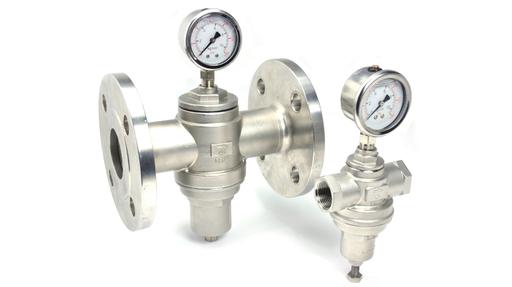A Pressure Reducing Valve (PRV) is an Automatic Control Valve that reduces a greater unregulated intake pressure to a consistent, lower downstream (outlet) pressure regardless of demand and/or upstream (inlet) water pressure changes. A Pressure Reducing Valve maintains a constant setpoint downstream.
You can utilize a High-Pressure Control Valve package set up for pressure-lowering applications to reduce pressure in high-pressure applications. An adjustable pilot valve in conjunction with an orifice controls the throttled position of the main valve (or needle valve). The pilot valve detects changes in downstream (outlet) pressure and reacts quickly when the outlet pressure rises or falls in response to changing demand.
The pilot detects the downstream (outlet) pressure and reacts quickly by adding or removing water from the top of the main valve diaphragm assembly, allowing the valve to reposition and throttle as the outlet pressure varies with flow demand. As the pilot diaphragm continuously regulates the main valve to throttle, open, or close and maintain the desired, preset lower output pressure, it will automatically sense variations in the system’s flow. The primary valve’s throttling action produces the requisite lowered downstream pressure.
Are you on the lookout for the best Pressure Reducing Valves on the market? We ranked them based on professional opinions. We’ve compiled a list of top options, which includes the best-selling Pressure Reducing Valve. Do you need an excellent Pressure Reducing Valve but can’t seem to find one? We understand this issue because we went through the entire Pressure Reducing Valve research process ourselves, which is why we’ve compiled a comprehensive list of the top and best Pressure Reducing Valves on the market right now. We have selected the best Pressure Reducing Valve for 2021 after hours of searching and using all of the types on the market. Take a look at our ranking below!
List of 10 Best Pressure Reducing Valves in 2024
According to the factors that we will mention in this article, Here is the List of 10 Best Pressure Reducing Valves in 2024:
- Model 70XL Water Pressure Reducing Valve Buy Now
- Model 500XL Water Pressure Reducing Valve with Integral By-pass Check Valve Buy Now
- Model ZW209BPEX Pressure Reducing Valves Buy Now
- Model 500XLHTSTSCYSBR Water Pressure Reducing Valve with Integral By-pass Check Valve Buy Now
- Model 500XLYSBR Water Pressure Reducing Valve Buy Now
- Watts 500 Series Pressure Reducing Valve Buy Now
- Honeywell Home 08622A1000 Pressure Reducing Valve Buy Now
- Arrowhead Water Products 100 PSI Pressure Reducing Valve Buy Now
- Zurn PRV-150 Pressure Reducing Valve Buy Now
- Watts 0500 Series Pressure Reducing Valve with Check Valve Buy Now
How We Selected Best Pressure Reducing Valves of 2024
A Pressure Reducing Valve is a critical component in any plumbing system. It helps to regulate the water pressure, preventing damage to fixtures and appliances. If your water pressure is too high, it can cause leaks, burst pipes, and even flooding. A PRV can help to prevent these problems by reducing the water pressure to a safe level.
We selected the best pressure reducing valves of 2024 based on a thorough analysis of more than 15 webpages and hundreds of products and reviewers. We also consulted with our experts to get their recommendations.
We are a team of experienced engineers and plumbers with a deep understanding of the plumbing industry. We have evaluated hundreds of pressure reducing valves over the years, and we are confident that the products we have selected are the best on the market.
We are committed to providing our readers with accurate and unbiased information. We only recommend products that we believe are of the highest quality and that will meet the needs of our readers.
Here are the steps we took to select the best pressure reducing valves of 2024:
- We analyzed more than 15 webpages and hundreds of products and reviewers.
- We consulted with our experts to get their recommendations.
- We evaluated each product based on a number of factors, including:
- Water pressure rating
- Flow rate
- Durability
- Price
- We selected the top 10 products based on our evaluation.
The products we selected are the best pressure reducing valves on the market. They are high-quality, durable, and affordable. We are confident that they will meet the needs of our readers. We hope this information helps you to select the best pressure reducing valve for your needs.
Best Pressure Reducing Valves Reviews
1. Model 70XL Water Pressure Reducing Valve
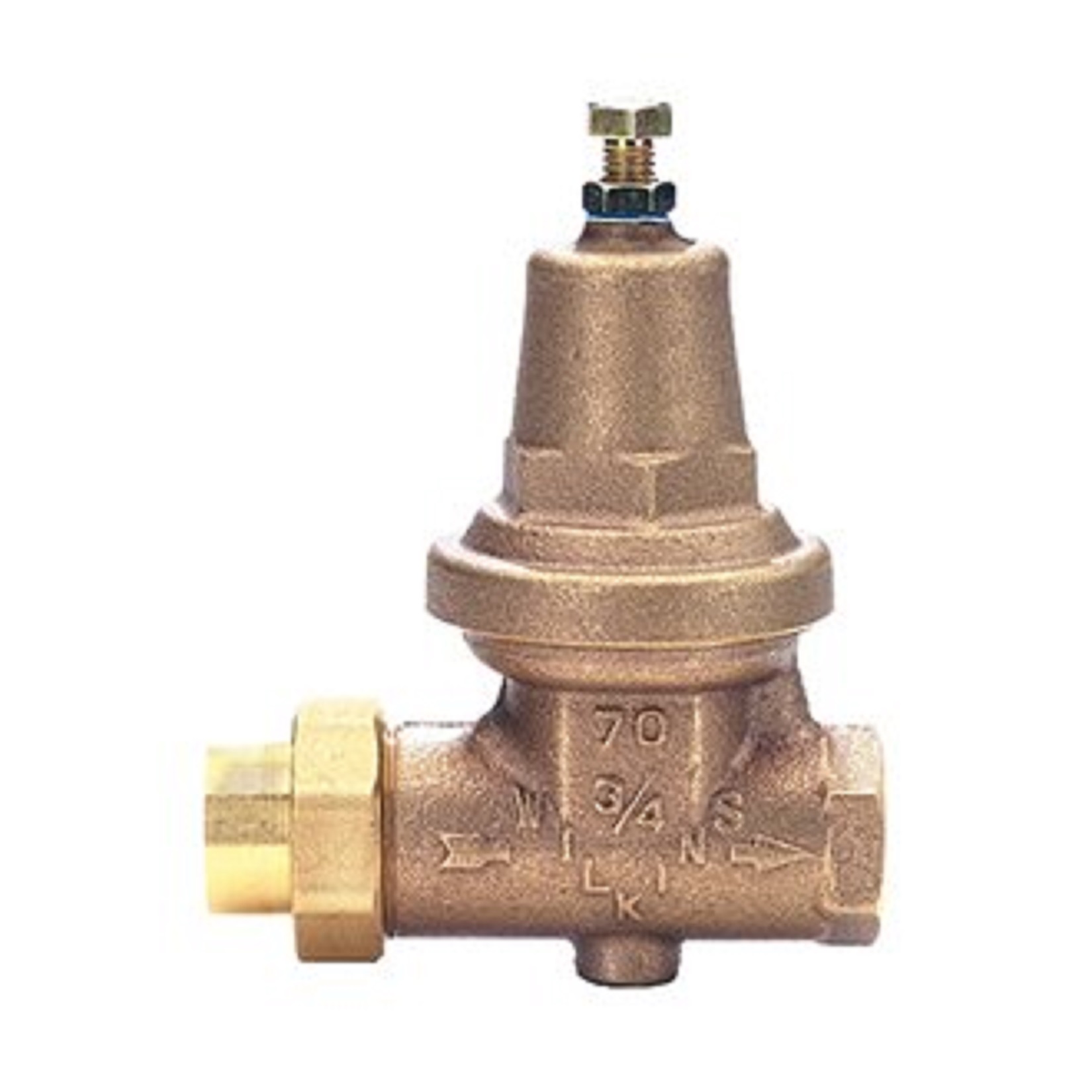
Specifications
| Sizes | 3/4″, 1″ |
| Maximum working water pressure | 300 psi |
| Maximum working water temperature | 140°F |
| Reduced pressure range | 25 psi to 75 psi |
| Factory preset | 50 psi |
General Descriptions
It is designed for installation on potable water lines to reduce high inlet pressure to lower outlet pressure and is appropriate for usage where Lead-Free valves are required. Cleaning and maintenance time is cut in half thanks to the unitized replaceable cartridge. The direct-acting integral bypass design avoids thermal expansion from causing excessive system pressure. The balanced piston design allows the regulator to react to variations in system flow demand smoothly and responsively while also protecting against inlet pressure changes.
Typical Installation
Installation requirements will be governed by local codes. The assembly must be installed in accordance with the manufacturer’s instructions and the most recent edition of the Uniform Plumbing Code unless otherwise stated. For testing and maintenance, the assembly must be mounted with enough side clearance.
The Model 70XL can be mounted in any orientation. Specify the “SC” sealed cage option if installed in a pit, vault, or indoors. For large demand changes or where the required pressure reduction is greater than 4 to 1, multiple installations are advised (i.e.: 200 psi inlet reduced to 50 psi outlet). A pressure gauge must be used downstream whenever a reduction valve is modified to ensure proper pressure setting. On the bell housing, do not use the bottom adjustment bolt.
2. Model 500XL Water Pressure Reducing Valve with Integral By-pass Check Valve
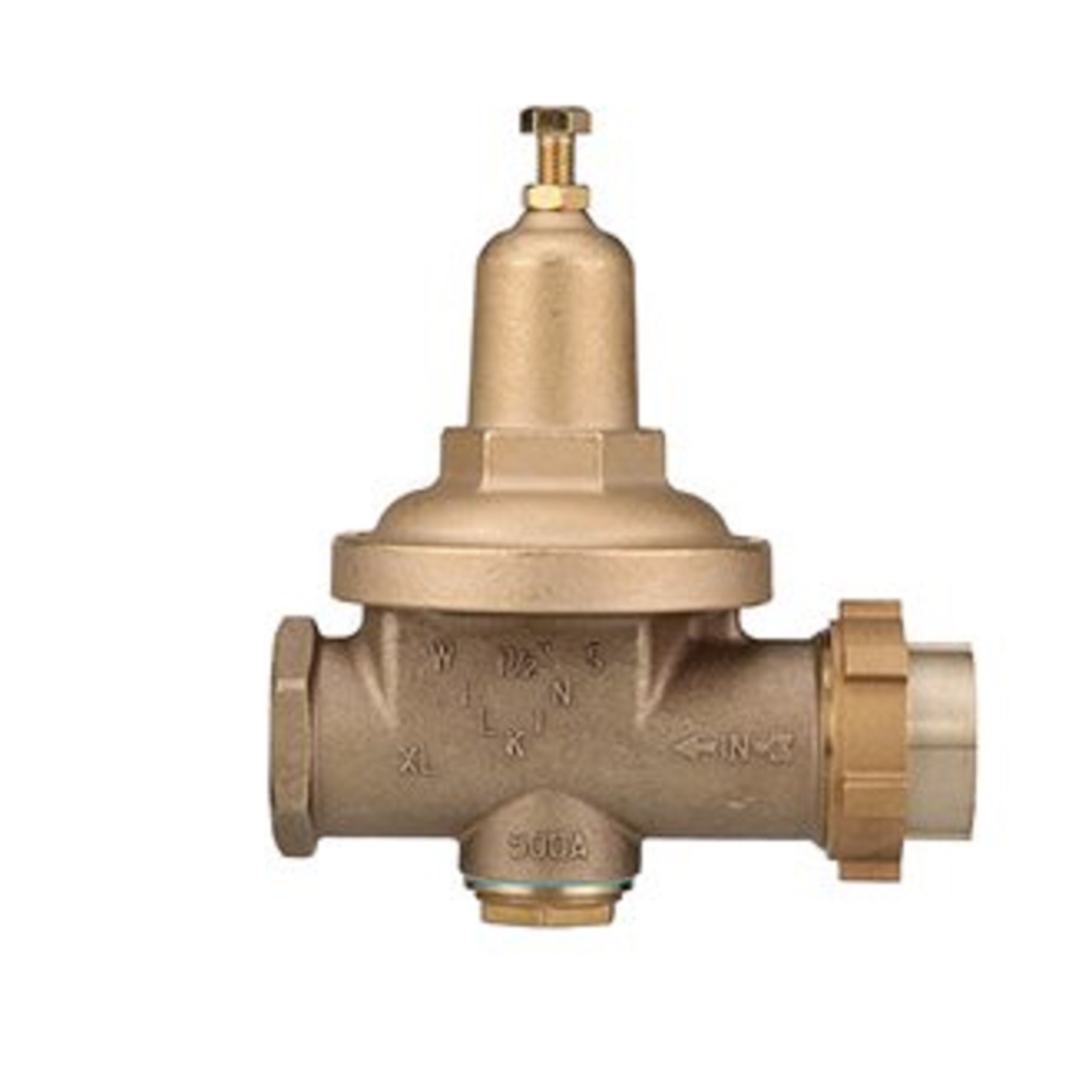
Specifications
| Sizes | 1/2″, 3/4″, 1″, 1 1/4″, 1 1/2″, 2″, 2 1/2″, 3″ |
| Maximum working water pressure | Gas |
| Maximum working water temperature | 140° F |
| Reduced pressure range | 25 psi to 75 psi |
| Factory preset (field set 2 1/2” & 3”) | 50 psi |
General Descriptions
The type 500XL is meant to reduce high inlet pressure to a lower outlet pressure on potable water lines. This device is best suited for industrial water lines and commercial water systems because of its large flow capacity. The direct-acting integrated by-pass design eliminates thermal expansion from causing excessive system pressure. The balanced piston design allows the regulator to react to variations in system flow demand in a smooth and responsive manner while also protecting against inlet pressure changes.
Typical Installation
For testing and maintenance, the assembly must be mounted with enough side clearance. The Model 500XL can be fitted anywhere. Specify the “SC” sealed cage option if installed in a pit, vault, or inside the application. For large demand changes or where the required pressure reduction is greater than 4 to 1, multiple installations are advised (i.e.: 200 psi inlet reduced to 50 psi outlet). A pressure gauge must be used downstream whenever a reduction valve is modified to ensure proper pressure setting. On the bell housing, do not use the bottom adjustment bolt.
See All Regulating & Pressure Reducing Valve for Sale
3. Model ZW209BPEX Pressure Reducing Valves

Specifications
| Threaded Pressure Rating | 400 psi max. |
| Flanged Pressure Rating | ANSI Class 150, 250 psi max. |
| Grooved Pressure Rating | 300 psi max. |
| Pilot Spring Range | 15-150 psi |
| Temperature Rating | Water 33°F to 140°F |
General Descriptions
The Pilot Operated Pressure Reducing Valve with Low Flow Model ZW209BPEX By-pass is used in a variety of applications where high entrance pressures must be reduced to a safe and stable exit pressure. The pilot assembly responds to variations in downstream pressure, allowing the main valve to vary between open and closed positions, ensuring that the downstream set pressure remains constant.
The main valve will seal shut whenever the downstream pressure reaches the pilot setting. The low flow bypass is set to a slightly greater pressure when the main valve closes, allowing it to manage very low flows up to 10 GPM during off-peak demand. (Flows between the bypass and the main valve minimum flow may require an extra bypass.) Additionally, the Model ZW209BPEX includes an epoxy coating for corrosion protection both internally and externally.
Typical Installation
In all circumstances, the ZW209BPEX is not a suitable replacement for a low-flow by-pass. The Typical Installation of valve is widely used in buildings with low flows of 1-15 GPM during off-peak periods. When sizing a pressure-reducing valve, many elements must be addressed, including inlet pressure, exit pressure, and flow rates.
Additional low-flow by-pass valves are sized using a minimum pressure differential of 50 psi between the inlet and set exit pressure. It may be essential to add an additional low flow by-pass valve to the ZW209BPEX installation to compensate for a range of predicted flows below the minimum continuous flow rate in order to generate a smooth seamless flow response. Set the valve you want to open first, 5 psi higher in static downstream set pressure to manage the opening point of the subsequent by-pass valves.
4. Model 500XLHTSTSCYSBR Water Pressure Reducing Valve with Integral By-pass Check Valve
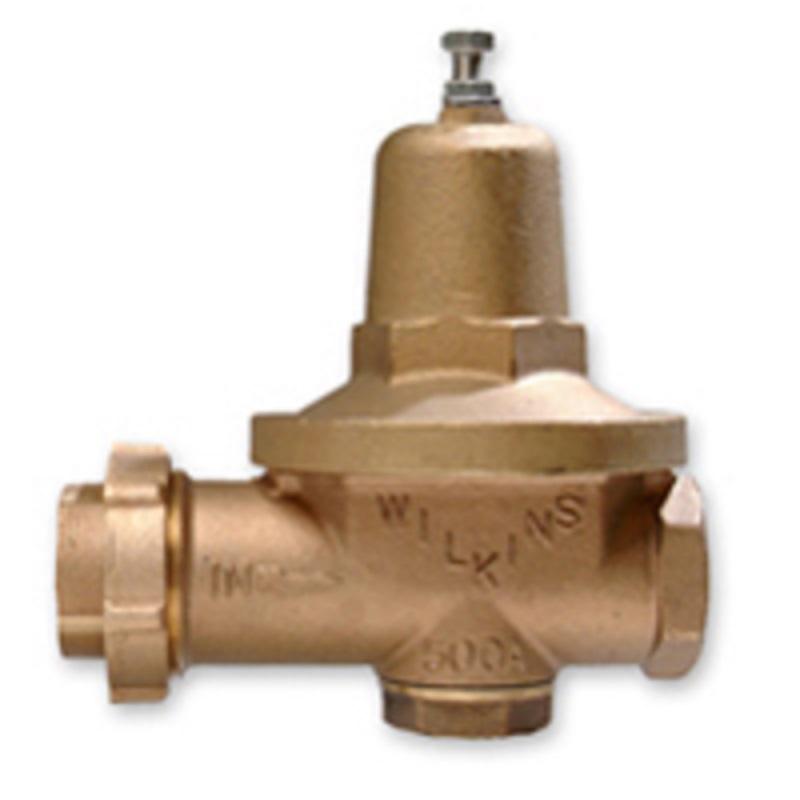
Specifications
| Sizes | 1/2″, 3/4″, 1″, 1 1/4″, 1 1/2″, 2″, 2 1/2″, 3″ |
| Maximum working water pressure | 300 psi |
| Maximum working water temperature | 180° F |
| Reduced pressure range | 25 psi to 75 psi |
| Factory preset | 50 psi |
| Threaded connections (FNPT) | ANSI B1.20.1 |
| Copper connections (FC) | ANSI B16.22 |
General Descriptions
It’s made to be installed on potable water lines to reduce high inflow pressure to lower exit pressure. For continuous hot water recirculation systems, the 500XLHTSTSCYSBR valves are appropriate. The Pressure Reducing Valve must be NSF/ANSI 61 certified and must have a low lead bronze body and bell housing, as well as a separate plunger access cover and a bolt to regulate the downstream pressure.
No ferrous screws are required for the bronze bell housing and access cap to be threaded into the body. The assembly must have a balanced piston design and be capable of reducing pressure in both flow and no-flow situations. The assembly must be serviceable without the need to remove the body from the line.
Typical Installation
The Model 500XLHTSTSCYSBR can be mounted in any orientation. For large demand changes or where the required pressure reduction is greater than 4 to 1, multiple installations are advised (i.e.: 200 psi inlet reduced to 50 psi outlet). CAUTION: A pressure gauge must be used downstream whenever a reduction valve is modified to ensure proper pressure setting. On the bell housing, do not use the bottom adjustment bolt.
5. Model 500XLYSBR Water Pressure Reducing Valve
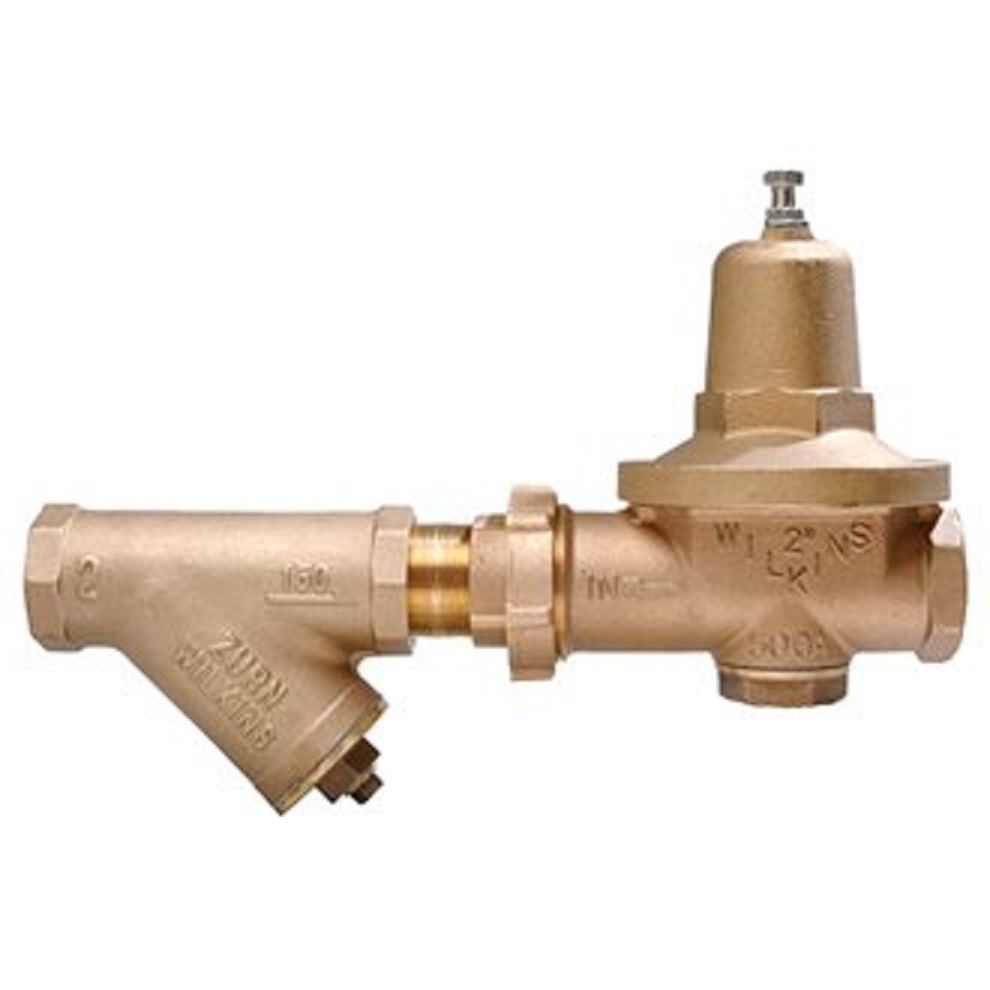
Specifications
| Sizes | 1/2″, 3/4″, 1″, 1 1/4″, 1 1/2″, 2″, 2 1/2″, 3″ |
| Maximum working water pressure | 300 psi |
| Boiler Warranty | Maximum working water temperature |
| Factory preset | 50 psi |
| Reduced pressure range | 25 psi to 75 psi |
General Descriptions
The type 500XLYSBR is designed to reduce high inlet pressure to a lower outlet pressure on potable water lines. This device is best suited for industrial water lines and commercial water systems because of its large flow capacity. The direct-acting integrated by-pass design eliminates thermal expansion from causing excessive system pressure. The balanced piston design allows the regulator to react to variations in system flow demand in a smooth and responsive manner while also protecting against inlet pressure changes.
Typical Installation
The Model 500XLYSBR can be mounted in any direction. Specify the “SC” sealed cage option if installed in a pit, vault, or inside the application. For large demand changes or where the required pressure reduction is greater than 4 to 1, multiple installations are advised (i.e.: 200 psi inlet reduced to 50 psi outlet). A pressure gauge must be used downstream whenever a reduction valve is modified to ensure proper pressure setting. On the bell housing, do not use the bottom adjustment bolt.
6. Watts 500 Series Pressure Reducing Valve

Specifications
| Inlet pressure | 50-165 psi |
| Outlet pressure | 20-165 psi |
| Flow rate | 10-20 GPM |
| Temperature range | 32-180 degrees Fahrenheit |
General Descriptions
The Watts 500 Series Pressure Reducing Valve is a mechanical pressure reducing valve that is used to reduce the water pressure in a plumbing system. The valve is made of durable brass and is easy to install and maintain. It is available in a variety of flow rates and pressure settings to meet the needs of different plumbing systems.
Typical Installation
The Watts 500 Series Pressure Reducing Valve is typically installed in the main water line of a plumbing system. The valve is installed between the water meter and the distribution system. The valve is plumbed using standard plumbing fittings.
7. Honeywell Home 08622A1000 Pressure Reducing Valve

Specifications
| Inlet pressure | 50-165 psi |
| Outlet pressure | 20-165 psi |
| Flow rate | 20-30 GPM |
| Temperature range | 32-180 degrees Fahrenheit |
General Descriptions
The Honeywell Home 08622A1000 Pressure Reducing Valve is a mechanical pressure reducing valve that is used to reduce the water pressure in a plumbing system. The valve is made of durable brass and is easy to install and maintain. It is available in a variety of flow rates and pressure settings to meet the needs of different plumbing systems. This valve is also a good option for those who need a high-flow rate.
Typical Installation
The Honeywell Home 08622A1000 Pressure Reducing Valve is typically installed in the main water line of a plumbing system. The valve is installed between the water meter and the distribution system. The valve is plumbed using standard plumbing fittings.
Here are the steps involved in installing the Honeywell Home 08622A1000 Pressure Reducing Valve:
- Turn off the main water supply.
- Disconnect the main water line from the water meter.
- Install the Honeywell Home 08622A1000 Pressure Reducing Valve in the main water line.
- Connect the main water line to the Honeywell Home 08622A1000 Pressure Reducing Valve.
- Turn on the main water supply.
Once the valve is installed, it is important to adjust the pressure setting to the desired level. The pressure setting can be adjusted using the adjusting screw on the valve.
The Honeywell Home 08622A1000 Pressure Reducing Valve is a reliable and durable pressure reducing valve that is easy to install and maintain. The valve is available in a variety of flow rates and pressure settings to meet the needs of different plumbing systems. This valve is also a good option for those who need a high-flow rate.
8. Arrowhead Water Products 100 PSI Pressure Reducing Valve

Specifications
| Inlet pressure | 50-165 psi |
| Outlet pressure | 20-165 psi |
| Flow rate | 20-30 GPM |
| Temperature range | 32-180 degrees Fahrenheit |
General Descriptions
The Arrowhead Water Products 100 PSI Pressure Reducing Valve is a mechanical pressure reducing valve that is used to reduce the water pressure in a plumbing system. The valve is made of durable brass and is easy to install and maintain. It is available in a variety of flow rates and pressure settings to meet the needs of different plumbing systems. This valve is also a good option for those who need a high-flow rate.
Typical Installation
The Arrowhead Water Products 100 PSI Pressure Reducing Valve is typically installed in the main water line of a plumbing system. The valve is installed between the water meter and the distribution system. The valve is plumbed using standard plumbing fittings.
Here are the steps involved in installing the Arrowhead Water Products 100 PSI Pressure Reducing Valve:
- Turn off the main water supply.
- Disconnect the main water line from the water meter.
- Install the Arrowhead Water Products 100 PSI Pressure Reducing Valve in the main water line.
- Connect the main water line to the Arrowhead Water Products 100 PSI Pressure Reducing Valve.
- Turn on the main water supply.
Once the valve is installed, it is important to adjust the pressure setting to the desired level. The pressure setting can be adjusted using the adjusting screw on the valve.
The Arrowhead Water Products 100 PSI Pressure Reducing Valve is a reliable and durable pressure reducing valve that is easy to install and maintain. The valve is available in a variety of flow rates and pressure settings to meet the needs of different plumbing systems. This valve is also a good option for those who need a high-flow rate.
9. Zurn PRV-150 Pressure Reducing Valve

Specifications
| Inlet pressure | 50-165 psi |
| Outlet pressure | 20-165 psi |
| Flow rate | 20-30 GPM |
| Temperature range | 32-180 degrees Fahrenheit |
General Descriptions
The Zurn PRV-150 Pressure Reducing Valve is a mechanical pressure reducing valve that is used to reduce the water pressure in a plumbing system. The valve is made of durable brass and is easy to install and maintain. It is available in a variety of flow rates and pressure settings to meet the needs of different plumbing systems. This valve is also a good option for those who need a high-flow rate. The Zurn PRV-150 Pressure Reducing Valve also comes with a backflow preventer, which helps to protect your plumbing system from contamination.
Typical Installation
The Zurn PRV-150 Pressure Reducing Valve is typically installed in the main water line of a plumbing system. The valve is installed between the water meter and the distribution system. The valve is plumbed using standard plumbing fittings.
Here are the steps involved in installing the Zurn PRV-150 Pressure Reducing Valve:
- Turn off the main water supply.
- Disconnect the main water line from the water meter.
- Install the Zurn PRV-150 Pressure Reducing Valve in the main water line.
- Connect the main water line to the Zurn PRV-150 Pressure Reducing Valve.
- Turn on the main water supply.
Once the valve is installed, it is important to adjust the pressure setting to the desired level. The pressure setting can be adjusted using the adjusting screw on the valve.
The Zurn PRV-150 Pressure Reducing Valve is a reliable and durable pressure reducing valve that is easy to install and maintain. The valve is available in a variety of flow rates and pressure settings to meet the needs of different plumbing systems. This valve is also a good option for those who need a high-flow rate and who want the added protection of a backflow preventer.
10. Watts 0500 Series Pressure Reducing Valve with Check Valve

Specifications
| Inlet pressure | 50-165 psi |
| Outlet pressure | 20-165 psi |
| Flow rate | 10-20 GPM |
| Temperature range | 32-180 degrees Fahrenheit |
General Descriptions
The Watts 0500 Series Pressure Reducing Valve with Check Valve is a mechanical pressure reducing valve that is used to reduce the water pressure in a plumbing system. The valve is made of durable brass and is easy to install and maintain. It is available in a variety of flow rates and pressure settings to meet the needs of different plumbing systems. This valve is also a good option for those who need a high-flow rate. The Watts 0500 Series Pressure Reducing Valve with Check Valve also comes with a backflow preventer, which helps to protect your plumbing system from contamination. The valve also has a gauge for monitoring pressure.
Typical Installation
The Watts 0500 Series Pressure Reducing Valve with Check Valve is typically installed in the main water line of a plumbing system. The valve is installed between the water meter and the distribution system. The valve is plumbed using standard plumbing fittings.
Here are the steps involved in installing the Watts 0500 Series Pressure Reducing Valve with Check Valve:
- Turn off the main water supply.
- Disconnect the main water line from the water meter.
- Install the Watts 0500 Series Pressure Reducing Valve with Check Valve in the main water line.
- Connect the main water line to the Watts 0500 Series Pressure Reducing Valve with Check Valve.
- Turn on the main water supply.
Once the valve is installed, it is important to adjust the pressure setting to the desired level. The pressure setting can be adjusted using the adjusting screw on the valve.
The Watts 0500 Series Pressure Reducing Valve with Check Valve is a reliable and durable pressure reducing valve that is easy to install and maintain. The valve is available in a variety of flow rates and pressure settings to meet the needs of different plumbing systems. This valve is also a good option for those who need a high-flow rate and who want the added protection of a backflow preventer and a gauge for monitoring pressure.
Here are some additional details about the Watts 0500 Series Pressure Reducing Valve with Check Valve:
- The valve is made of durable brass and is resistant to corrosion.
- The valve is easy to install and maintain.
- The valve is available in a variety of flow rates and pressure settings to meet the needs of different plumbing systems.
- The valve comes with a backflow preventer, which helps to protect your plumbing system from contamination.
- The valve has a gauge for monitoring pressure.
The Watts 0500 Series Pressure Reducing Valve with Check Valve is a reliable and durable pressure reducing valve that is a good option for a variety of plumbing systems. The valve is easy to install and maintain, and it is available in a variety of flow rates and pressure settings to meet the needs of different plumbing systems. The valve also comes with a backflow preventer and a gauge for monitoring pressure.
FAQs about Pressure Reducing Valves
Why Should We Have a PRV?
High water pressure in the home plumbing system can lead to leaking water heaters, dripping faucets, banging water pipes, dishwasher and washing machine noise and failure, and leaking water pipes. Water running at a faster rate than is required to meet regular fixture or appliance needs, can be harmful, wasteful, and shorten the life of equipment in homes. Maintaining a predetermined pressure in the house, often 50 pounds per square inch (psi), can help to ensure that the plumbing and appliances in the home run at a safe, moderate, but sufficient pressure.
Where Should the Pressure Regulator Be Installed?
On new installations, the pressure regulator is normally positioned downstream (on the home side) of the water meter, near the house. These may be bought from a home improvement or plumbing supply store and are quite easy to install, making them a do-it-yourself project. You can, however, contact a certified plumbing contractor in your area for an estimate.
How Long Will a Water Pressure Reducing Valve Last?
A water pressure regulator’s life expectancy is typically 10 to 15 years. However, if a regulator is properly maintained, it can fail after three years and still function correctly after 20 years.
Because previously, a malfunctioning water pressure reducing valve was not replaced but cleaned or repaired with an affordable service kit, PRVs have been dubbed “life-of-mortgage” items. Because dirt or foreign matter on the seating area can cause problems, it is designed similarly to the kitchen faucet. Repairing a water pressure-reducing valve is no more difficult than repairing a kitchen faucet.
How Do We Know If Our Pressure Reducing Valve Is Bad?
- Water pressure that is diminishing or fluctuating.
- There is no water pressure.
- Walls that are thumping, slamming, hammering, or shaking.
- High water pressure, leaking faucets, and a toilet that never stops running.
How Do We Check Our Pressure Coming into The House?
The most precise technique is to purchase a pressure gauge and connect it to a hose faucet/bib at your local hardware store. Check the pressure when all other faucets and water-using appliances are turned off to get a baseline reading. In general, the pressure in your home plumbing should be between 30 and 80 psi.
Conclusion
If you require the best pressure reducing valves and have a limited amount of time for your application, you can contact one of our Pressure Reducing Valve Service Providers.
Read More on Linquip
- Regulating & Pressure Reducing Valve Manufacturers
- Needle Valve Manufacturers
- Hydraulic Valves Manufacturers
- Pinch Valve Manufacturers
- Valve Manufacturers
- The Best Blow off Valves
- The 6 Best Tubeless Valve Stems
- The 10 Best Shower Valves
- The 10 Best Toilet Fill Valves
- Top Control Valve Suppliers in the USA
- Top Check Valve Manufacturers in the USA
- Top Valve Suppliers and Manufacturers All Over the World
- Regulating & Pressure Reducing Valve Suppliers and Companies
- Solenoid Valve Suppliers and Companies
- Pinch Valve Suppliers and Companies
- Safety & Relief Valve Suppliers and Companies
- Pneumatic actuators Suppliers and Companies

